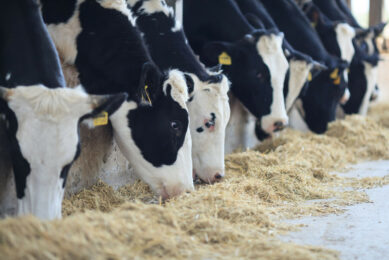Kemin seminar delves into nutrient optimisation

Profitability increases by optimising nutrient release and absorption combined with a preventive animal health focus are without doubt the two most important needs in today’s animal production. This was stated by KP Philip, president of animal nutrition and health division of Kemin at a recent Kemin seminar.
A panel of experts addressed the key aspects affecting nutrient absorption at the seminar, a novel tool was also launched there.
The seminar was kicked off by keynote speaker from Vlerick School of Business – Prof Ralf Wetzel – who challenged the minds of the audience how to make decisions in a fast changing world – in an interactive workshop. “Our world has changed dramatically recently, and becomes much more uncertain, volatile and complex. The speed at which we have to change and learn has increased significantly. Often we are over thinking before making a decision, or minds are trapped in old frames and we have fear to decide and potentially fail. Therefore we have to adapt, learn to improvises, play, decide quickly and say yes to the unexpected”, Weztel said.
Maximise feed utilisation
The scientific seminar was opened by Dr Clifford Adams, who reviewed the current state of the art of nutrient absorption. In order to optimise the efficiency of nutrient absorption, one needs to maximise feed utilisation and minimise environmental pollution. Unfortunately less than 50% of the available nitrogen and phosphorus is utilised by the animals, indicating there is still a long way to improve nutrient efficiency. A short introduction to some nutritional strategies which can support nutrient absorption were discussed.
Improve fat digestion
Dr Matias Jansen, animal nutrition and health division of Kemin in Europe, reviewed the tools nutritionists have to improve fat digestion. Dr Jansen explained that in order to improve fat digestion, one needs to evaluate how nutritional additives can improve all steps in the lipid digestion process, including lipid emulsification, lipid hydrolysis, and micelle absorption. Scientific data derived from a complete fat digestion model was presented on how three classes of additives (synthetic emulsifiers, lecithins, and lysolecithins), to different degrees impact the emulsification, hydrolysis, and absorption step. Only lysolecithins significantly improved all three steps in the lipid digestion process. Trial results on a natural bio-surfactant and absorption enhancer, which is based on a specific mixture of lysolecithins, were workshopped in a meta-analysis on a global basis. This analysis took into account variations in diet related factors, different lipid sources used in the feed formulation, different rearing conditions, and variations in animal age. Overall conclusions are that the natural bio-surfactant significantly improves crude fat digestion and absorption. Therefore Dr Jansen stated that the product is a proven tool that gives nutritionists the opportunity to improve and optimise lipid digestion, nutrient absorption and consequently reduce feed costs.
Poultry session
In the poultry session, Prof Sebastian A. Kaczmarek, Poznan University, Poland presented the studies from a novel and timely study that evaluated the effect of a slow release calcium butyrate versus avilamycin that was published in Poultry Science1. The timing of this study, is critically important as the global trend and pressure to move away from antibiotics continues. The alternative, butyric acid, is a short chain fatty acid which is known to be involved in mucosal immune response and to have an anti-inflammatory effect in animals. Although butyric acid is a small molecule, it can have diverse modes of action, such as increase villi height and crypt depth, leading to increases in absorptive surface of the small intestine and resulting in better nutrient utilization. As butyrates are so quickly absorbed and metabolised, an encapsulation technology is needed in order to secure the slow release of the butyrate in the small intestine. A slow release calcium butyrate** which has been tested in a C14 labelled study to have a targeted release of butyric acid in the small intestine2. In a recent study, the efficacy of the slow release calcium butyrate versus avilamycin was studied. Both the slow release calcium butyrate (300 g /ton) and avilamycin (6 mg / kg active substance) treated groups were able to demonstrate a statistically significant difference versus the control group on body weight gain (BWG) and feed conversion ratio (FCR).
Swine session
How can we give piglets a good start and support their animal health was the topic which Francis Mollist, Schothorst, Netherlands addressed. Feeding strategies for young piglets around the age of 21 days were reviewed. Reiterating the importance on the economics related to swine production, Dr Mauro Di Benedetto, senior technical service manager at Kemin, reminded the audience that approximately 70% of swine production costs are derived from feed prices so reducing feed conversion through improved digestibility or increased nutrient absorption has never been more important.
The most common ideology among swine producers is that production can be increased through the amount of live born weaned piglets. However, Dr Di Benedetto explained that a 0.1 reduction in feed conversion results in the same profit as an additional two weaned piglets born per litter. This reduction in feed conversion can easily be obtained through the use of nutritional tools which help determine the proper ingredient values and which improve nutrient absorption. Novel data on how Lysoforte supports the sow’s absorption of nutrients was presented. In addition, a recent trial conducted at Schothorst Feed Research indicated that the unique bio-surfactant Lysoforte Booster Dry reduced swine feed cost 7€/ton of feed during the grower phase while increasing an additional income of 0.8€ per pig versus the control group.
Launch of new bio-surfactant tool
During the seminar, Kemin also launched Lysoforte Liquid, a bio-surfactant, which revolutionises the application process by directly dosing the bio-surfactant into the oil and fat application line. This state-of-the-art system was created by a team of engineers who worked to make applying the liquid product directly into the oil and fat line easy and convenient at the feed mill. During the seminar several insights how to improve nutrient absorption were discussed and with Lysoforte liquid a novel tool is made available.
Author: Kemin
*LYSOFORTE®, ** ButiPEARL™
1Poultry Science 2016, 00:1–9 Smith J. et al. In Vitro Dissolution and In Vivo Absorption of Calcium [1-14C] Butyrate in Free or Protected forms. Journal of Agricultural Food Chemistry 2012.












